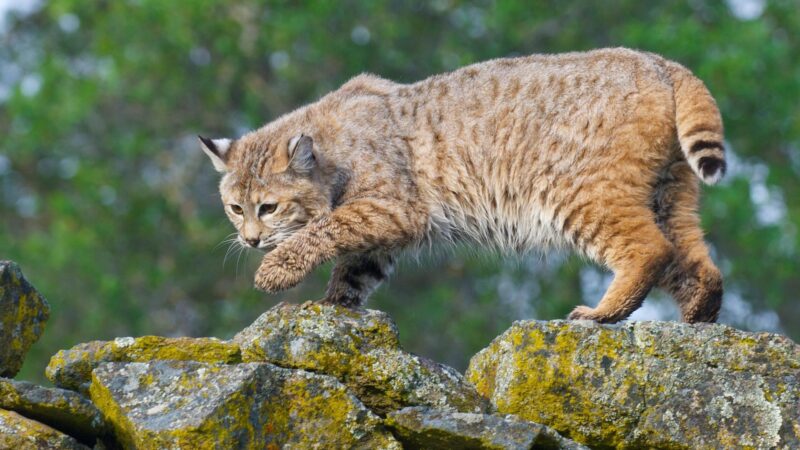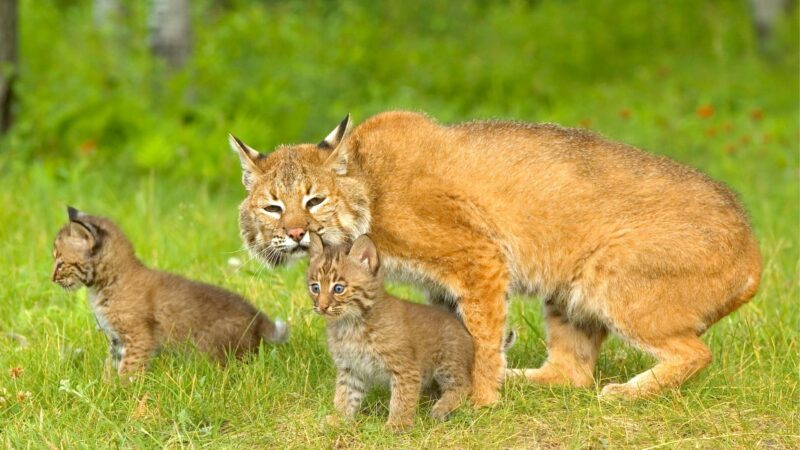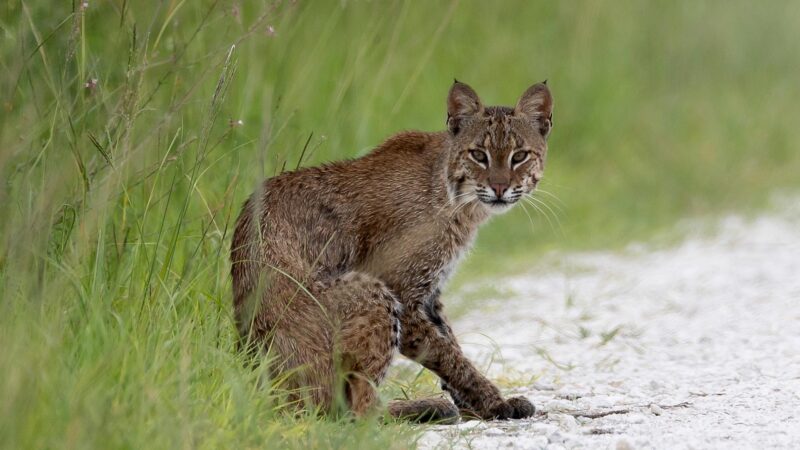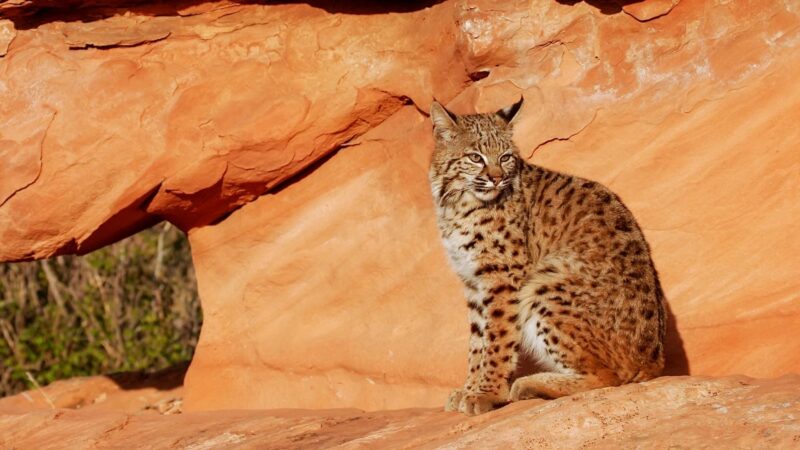Animal feces can be found anywhere where animals are present. How can we know what kind of animal defecates in a certain area, whether it be a dog or a bobcat that can only be seen in forests?
So, what does bobcat poop look like? Bobcat poop is somewhat similar to a dog or cat poop. However, it is not as solid as the other droppings. As a result of their diet, bobcat wastes often include fur or bone and are also accompanied by urine that makes it smelly.
In this article, you will discover more about this animal, it’s “not-so-smelly dropping,” and how to recognize it!
Table of Contents
What Is a Bobcat?

Bobcats, also known as wildcats, are near twice the size of a typical housecat. They have the same long legs, huge paws, and tufted ears as their larger cousin, the Canada lynx. The bobcat is nocturnal since it is most active at dusk. It is in motion from three hours before sunset to around midnight and then again from three hours before sunrise to three hours after sunrise.
- Appearance: Bobcats have blue eyes and long, muscular legs that help them run and climb trees. Their tails are shorter than their bodies and are covered in fur except at the tip of the tail where it is naked.
- Lifespan: The average lifespan for a bobcat is about 15 years, but it can be as short as 10 or as long as 20. In general, smaller bobcats tend to live shorter lives than larger ones; however, they may have longer lifespans in colder climates.
- Height: Bobcat height ranges from 3 to 4 feet, depending on the subspecies. They are considered medium-sized cats, standing 20 inches high and 30-50 inches long.
- Weight: The average weight of a male bobcat is between 13.5 to 20 pounds and can grow to up to 40 pounds. Females weigh between 8 and 14 pounds and can grow up to 33 pounds.
- Color: Bobcats are identified by their brown or red fur. On their bellies, they have lighter fur hues, and their ears have black tips. They are also recognized for having a tail with a color pattern that matches the rest of their fur.
- Place of Origin: The bobcat’s range includes most of Canada, Alaska, northern Mexico, parts of the US states of California (including Baja California Peninsula and San Diego County), Arizona (including Santa Catalina Island), and New Mexico (including Chaco Canyon). It is found in grassland habitats throughout its range except for arid regions.
- Characteristics: The bobcat is a member of the weasel family. They are considered nocturnal animals. Bobcats are also known for their ability to adapt to their environments and live comfortably in areas that other animals cannot.
What Do Bobcats Eat?

Bobcats are omnivores, which means they eat both plants and meat. They usually eat small rodents and birds when they can find them, but they also feed on rabbits, deer, snakes, and even amphibians.
Bobcat Poop Identification
- Color: Bobcat poop is usually reddish-brown in color. It may be darker or lighter than this, depending on the diet of the bobcat and its age. The most common type of bobcat poop color is red, but it may also have a yellow tinge to it.
- Length and Shape: The average length of a bobcat’s poop is 1.5 inches depending on their consumption of food. The poop is shaped like a wedge or a pyramid with the apex pointing up.
- Smell: Bobcat poop smell is a natural scent that comes from the cat’s digestive system, but sometimes it is smelly if it is accompanied by urine. The smell is caused by bacteria that live in the cat’s digestive tract. The bacteria produces a gas called hydrogen sulfide, which gives off a very unpleasant smell.
- Texture: The texture of bobcat’s poop is a mixture of sand and clay, which gives it a slightly sandy or gritty feel. Sometimes its poop is covered with fur and clay.
- Contents: Bobcat poop content is very high in protein, fat, and fiber. The three most abundant minerals in bobcat feces are sodium, potassium, and magnesium. Bobcat feces contains less than one percent of the phosphorus found in cow or sheep manure.
- Location: Bobcat poop can be found in areas that are accessible to humans, such as roadsides, fields, and residential areas. It can also be found on the ground, but it’s also abundant in trees.
What Can Bobcat Poop Tell Us?

Bobcat poop can tell us a lot about the conditions of the animal’s environment and whether it is healthy or has a balanced ecosystem. This indicates that bobcat feces may indicate the presence of prey in the bobcat’s habitat. However, their presence in homes and fields indicates that they are on the move and searching for more food resources.
Do Bobcats Cover Their Poop?

Bobcats do cover their poop. This is because they are one of the few animals that have scent glands on their chin and jaw.
For some animals like bobcats, uncovered feces indicates territory. This is why bobcats hide their waste to avoid predators. Burying feces decreases scents, which may be beneficial for weaker animals who don’t desire to be seen.
What Is the Difference Between a Bobcat Scat and Mountain Lion Droppings?
Bobcat feces are typically smaller than mountain lion droppings, and they tend to be reddish-brown in color.
Mountain lion droppings come in a variety of sizes and shapes, but they are always large enough that you can see them from a long distance away. The feces will also be shaped like small balls with sharp edges and fur on them.
What Is the Difference Between a Bobcat Scat and Bear Droppings?
Bear droppings are typically larger than bobcat droppings and contain more hair, bones, and other organic matter. Additionally, bear droppings tend to be composed of higher-quality food than bobcat droppings and also have more water content than bobcat droplets.
What Is the Difference Between a Bobcat Scat and Lynx Droppings?
Bobcat scat is usually black or dark brown in color and smelly when fresh. It can be found in open areas with little vegetation and often contains bones, hair, skin, and bone marrow.
Lynx scat is usually gray or light gray in color and smells like skunk spray when fresh. They can also be found in areas with lots of vegetation and a lot of prey for them to eat.
What Is the Difference Between a Bobcat Scat and Fox Droppings?
Fox droppings are smaller than bobcat scat, with smaller particle diameters. They are also much less frequent than the larger batches of poo found in the bobs’ scat.
The color of fox droppings is usually gray or brown, whereas bobcat scat is typically red or black. Foxes tend to eat berries and other fruits that produce red fruit, while bobs prefer meaty plants and insects that leave behind red droppings.
What Is the Difference Between a Bobcat Scat and Otter Droppings?
Bobcat scat is usually made up of small pieces from the digestive tract and includes hair, bones, nails, feathers, fur, and other small animal parts. Otter droppings are made up of solid material left by the digestive system of an otter. Otters are carnivorous mammals that prey on fish and other animals living in freshwater bodies such as rivers and lakes.
What Is the Difference Between a Bobcat Scat and Hedgehog Droppings?
Bobcat scat and hedgehog droppings are very similar, but there are some key differences that help to distinguish between the two. Bobcat scat is made up of feces and urine, while hedgehog droppings are made up of feces, although some hedgehogs will also leave tufts of fur.
Additionally, bobcat scat is usually found along the edges of forests and other wooded areas, where the animals like to travel. Hedgehog droppings are found in long grasses and shrubs, on open ground near forests, and sometimes in bogs.
What Is the Difference Between a Bobcat Scat and Pine Marten Droppings?
The first difference between the two is that bobcat scat is a lot smaller than pine marten droppings. Bobcat droppings can be as small as 0.5 inches long, while pine marten droppings are much larger—up to 4 inches long, depending on the size of the animal. Another difference between these two types of scats is that bobcat scat has a reddish-brown to it while pine marten droppings have a grayish-brown color.
What to Do if You Find a Bobcat Scat in Your Locality?
If you find a bobcat scat in your locality, it’s important to contact a wildlife professional immediately. Bobcats are known to carry diseases, and their scat can contain more than just animal poop.
If you live in a rural location or near a forest, you should be on the alert for bobcats. If you encounter one, you should notify your local municipality or the hunter’s association so they can take appropriate measures before any harm comes to anyone else.